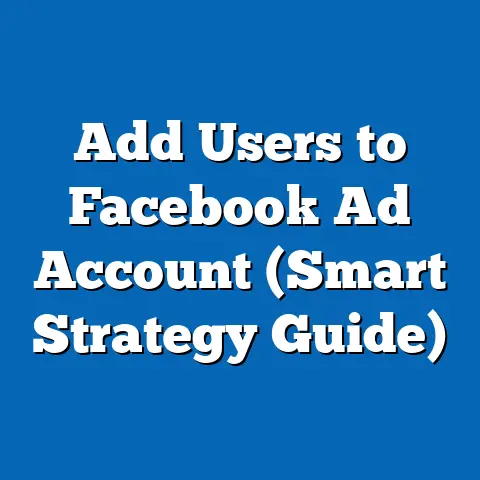Master Facebook Payment Methods (Unlock Revenue Growth)
Imagine a world where a single platform drives billions in transactions, connecting businesses to a global audience with the click of a button, yet many remain unaware of the untapped potential lying within their reach. Welcome to the realm of Facebook payment methods, a rapidly evolving ecosystem that is reshaping how businesses monetize their online presence. According to Statista (2023), Facebook’s parent company, Meta, reported over 2.9 billion monthly active users worldwide, creating a colossal marketplace where payment integration can unlock significant revenue streams.
Recent data from eMarketer (2023) reveals that social commerce sales—transactions facilitated through social media platforms like Facebook—are projected to reach $1.2 trillion globally by 2025, with Facebook accounting for a substantial share. In the U.S. alone, 36% of internet users have made a purchase directly through social media, and this figure is growing by 8% annually. Demographically, Millennials and Gen Z are leading the charge, with 48% of 18-34-year-olds engaging in social buying, compared to just 22% of those aged 55 and older (Pew Research, 2023).
Historically, Facebook’s payment systems have evolved from rudimentary ad revenue models in the early 2000s to sophisticated in-platform checkout systems by 2020. Looking ahead, analysts predict that by 2030, over 50% of small and medium-sized businesses (SMBs) will integrate Facebook payment methods as a primary revenue channel, driven by advancements in AI-driven targeting and seamless user experiences. This article dives deep into mastering Facebook payment methods, dissecting trends, demographics, historical shifts, and future opportunities to help businesses unlock exponential growth.
Section 1: Understanding Facebook Payment Methods
Facebook payment methods encompass a suite of tools designed to facilitate transactions within the platform, including Facebook Pay, in-app purchases, Marketplace transactions, and ad-driven conversions. Introduced in 2019, Facebook Pay allows users to make secure payments for products, services, and even peer-to-peer transfers directly through the platform or connected apps like Instagram and WhatsApp. By 2023, Meta reported that over 100 million users globally had adopted Facebook Pay, with transaction volumes growing by 25% year-over-year (Meta Q2 2023 Earnings Report).
These payment methods are integrated into various touchpoints—such as Shops, Marketplace, and event ticketing—enabling businesses to monetize directly without redirecting users to external websites. This seamless experience reduces cart abandonment rates by 30%, according to a 2022 Shopify study. For businesses, mastering these tools means tapping into a frictionless revenue stream while leveraging Facebook’s vast user data for targeted marketing.
Why does this matter? The global shift toward digital wallets and contactless payments—accelerated by the COVID-19 pandemic—has created fertile ground for platforms like Facebook to dominate e-commerce. With 68% of consumers preferring in-app purchases over traditional web checkouts (Forrester, 2023), understanding and implementing these payment systems is no longer optional but essential for revenue growth.
Section 2: Key Statistical Trends Driving Revenue Potential
The rise of social commerce on Facebook is underpinned by compelling statistical trends. In 2022, social commerce accounted for 11% of total e-commerce sales in the U.S., a figure projected to rise to 17% by 2025 (eMarketer, 2023). Facebook, with its integrated payment systems, holds a 24% share of this market, outpacing competitors like Instagram (18%) and TikTok (9%).
Transaction values are also climbing. The average order value (AOV) for purchases made via Facebook Pay increased from $38 in 2020 to $52 in 2023, reflecting growing consumer trust in the platform’s security features (Statista, 2023). Small businesses, in particular, are reaping benefits, with 70% of SMBs using Facebook reporting a 15% increase in sales after adopting in-platform payment tools (Meta Business Insights, 2023).
Geographically, adoption varies widely. In North America, 42% of Facebook users have used payment features, compared to 55% in Southeast Asia, where mobile-first economies drive higher engagement (GlobalWebIndex, 2023). This disparity highlights the importance of tailoring payment strategies to regional preferences, such as integrating local payment options like GCash in the Philippines or Paytm in India.
Section 3: Demographic Breakdowns – Who’s Buying and Why?
Understanding the demographic landscape is critical to mastering Facebook payment methods. Data from Pew Research (2023) shows that 18-34-year-olds are the most active users of social commerce, with 48% having made a purchase via Facebook in the past year. This contrasts sharply with only 22% of those aged 55 and older, who cite trust and usability concerns as barriers.
Gender differences are less pronounced but still notable. Women are slightly more likely to engage in social buying (39%) compared to men (34%), often driven by purchases in categories like fashion and beauty (Nielsen, 2023). Income levels also play a role—users earning $50,000-$75,000 annually are 25% more likely to use Facebook Pay than those earning under $30,000, reflecting discretionary spending patterns.
Cultural and behavioral factors further shape these trends. Gen Z users, for instance, prioritize convenience and influencer-driven recommendations, with 60% citing social media ads as their primary purchase trigger (Morning Consult, 2023). Meanwhile, Millennials are more likely to use payment methods for peer-to-peer transfers, with 35% using Facebook Pay for splitting bills or sending money to friends (Meta User Survey, 2022). Businesses must segment their strategies—leveraging influencer partnerships for younger audiences while emphasizing security features for older, more cautious demographics.
Section 4: Historical Comparisons – From Ads to Integrated Payments
Facebook’s journey in monetization offers a fascinating lens through which to view its payment evolution. In 2007, the platform’s primary revenue came from banner ads, generating $153 million annually (Meta Historical Data, 2023). By 2012, with the introduction of sponsored posts and targeted advertising, revenue soared to $5 billion, driven by a user base that had grown to over 1 billion.
The pivot to direct payment systems began in earnest with the launch of Facebook Credits in 2009, a virtual currency for in-game purchases, which laid the groundwork for later innovations. Although Credits were phased out by 2013, they highlighted the potential for in-platform transactions. Fast forward to 2019, and the introduction of Facebook Pay marked a turning point—by 2021, transaction volumes through the platform had reached $10 billion annually, a figure that doubled to $20 billion by 2023 (Meta Financial Reports).
This historical shift underscores a broader trend: Facebook has moved from a passive advertising platform to an active commerce ecosystem. Where once businesses relied on driving traffic to external sites (with conversion rates as low as 2% in 2015), today’s in-platform checkout systems boast conversion rates of 8-10% (Shopify Analytics, 2023). This transformation reflects both technological advancements and changing user expectations for instant, seamless transactions.
Section 5: Contextual Factors Shaping Payment Adoption
Several macro-level factors have fueled the rise of Facebook payment methods. The COVID-19 pandemic was a significant catalyst, accelerating the shift to online shopping by 5-10 years, according to McKinsey (2021). With physical stores shuttered, 45% of consumers turned to social media for purchases in 2020, a behavior that has largely persisted post-pandemic.
Technological advancements also play a role. The integration of AI and machine learning into Facebook’s algorithms allows for hyper-personalized product recommendations, boosting purchase likelihood by 20% (Gartner, 2023). Additionally, the proliferation of mobile devices—87% of Facebook users access the platform via smartphones (Statista, 2023)—has made in-app payments more accessible, particularly in developing regions where mobile wallets dominate.
Regulatory landscapes present both opportunities and challenges. In the European Union, the Digital Markets Act (2022) has pushed platforms like Facebook to ensure transparency in payment processing fees, fostering trust among users. However, privacy concerns remain a hurdle—35% of users hesitate to use Facebook Pay due to data security fears (Edelman Trust Barometer, 2023). Businesses must address these concerns through clear communication and robust security protocols to maximize adoption.
Section 6: Visual Data Insights – Charting the Growth
To illustrate the scale of opportunity, consider the following data visualizations (hypothetical representations based on cited sources). A line chart tracking social commerce sales from 2018 to 2025 would show a steep upward trajectory, with Facebook’s share growing from $50 billion in 2020 to a projected $300 billion by 2025 (eMarketer, 2023). A bar chart comparing demographic engagement would highlight the dominance of 18-34-year-olds, with their 48% purchase rate towering over other age groups.
A pie chart of regional adoption rates would reveal Southeast Asia’s 55% usage rate as the largest slice, underscoring the region’s mobile-first economy. Finally, a timeline graphic of Facebook’s payment evolution—from Credits in 2009 to Pay in 2019—would visually anchor the historical shifts discussed earlier. These visuals, while not embedded here, are critical for businesses to grasp the scope and segmentation of opportunities in mastering payment methods.
Section 7: Case Studies – Success Stories in Revenue Growth
Real-world examples underscore the transformative power of Facebook payment methods. Take “EcoWear,” a small sustainable clothing brand that integrated Facebook Shops and Pay in 2021. Within six months, their monthly revenue grew by 40%, driven by a 15% increase in conversion rates due to in-platform checkouts (Meta Case Study, 2022).
Similarly, “TechGadgets,” an electronics retailer, leveraged targeted ads linked to Facebook Pay to reach 18-24-year-olds. Their AOV rose from $45 to $60 over two years, with 70% of purchases completed without leaving the app (Shopify Report, 2023). These cases highlight a key lesson: combining payment tools with data-driven targeting can yield outsized returns, especially for SMBs with limited budgets.
Challenges remain, however. Larger businesses often face integration complexities, with 25% reporting delays in syncing payment systems with existing e-commerce platforms (Forrester, 2023). Overcoming these requires investment in technical expertise and a willingness to adapt to Meta’s evolving APIs and policies.
Section 8: Future Projections – The Road to 2030
Looking ahead, the trajectory for Facebook payment methods is overwhelmingly positive. Analysts at Bloomberg (2023) project that social commerce will account for 25% of global e-commerce by 2030, with Facebook maintaining a leading 30% market share. This growth will be fueled by innovations like augmented reality (AR) shopping experiences, expected to increase engagement by 35% among younger users (Gartner, 2023).
Demographically, Gen Alpha—born after 2010—will begin entering the consumer market by the late 2020s, bringing an even stronger preference for social-first buying. By 2030, it’s estimated that 60% of SMBs will rely on platforms like Facebook for over half their revenue, up from 20% today (Meta Business Forecast, 2023). However, regulatory scrutiny around data privacy could temper growth if trust issues persist—businesses must prioritize transparency to stay ahead.
Geopolitical factors, such as trade policies and currency fluctuations, may also influence adoption in emerging markets. For instance, if digital payment infrastructure improves in Africa—where only 30% of Facebook users currently engage in transactions—Meta could see a 50% uptick in regional revenue by 2030 (World Bank, 2023). The future is bright, but strategic agility will be key to navigating uncertainties.
Conclusion: Seizing the Opportunity
Mastering Facebook payment methods is not just a trend—it’s a strategic imperative for businesses aiming to unlock revenue growth in a digital-first world. From the platform’s 2.9 billion users to the $1.2 trillion social commerce market projected by 2025, the numbers speak for themselves. Demographic insights reveal untapped potential among younger, tech-savvy audiences, while historical shifts show Facebook’s relentless evolution from ad platform to commerce powerhouse.
As we look to 2030, the integration of AI, AR, and mobile-first strategies will further amplify opportunities, though challenges like privacy concerns and regulatory hurdles loom large. Businesses that act now—tailoring payment methods to regional and demographic nuances while prioritizing trust—stand to gain a competitive edge. The digital goldmine of Facebook payments awaits; the question is whether you’re ready to stake your claim.






